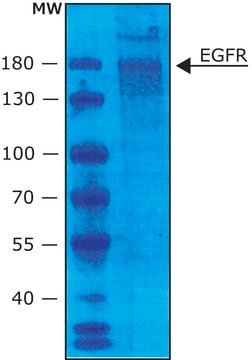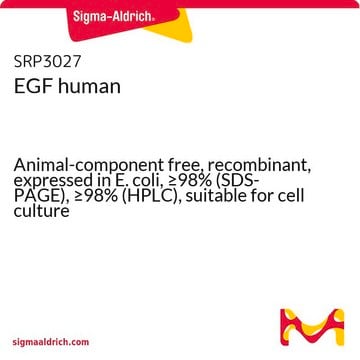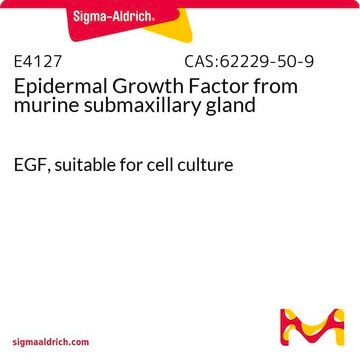E2645
Epidermal Growth Factor Receptor human
lyophilized powder, ≥15,000 units/mg protein (Bradford)
Synonym(s):
ERBB, ErbB1, HER1, EGFR
About This Item
Recommended Products
biological source
human
Quality Level
form
lyophilized powder
potency
>15000.00 units/mg
specific activity
≥15,000 units/mg protein (Bradford)
mol wt
~170 kDa
packaging
pkg of 500UN
storage condition
avoid repeated freeze/thaw cycles
technique(s)
cell based assay: suitable
color
white
solubility
glycerol: 10%, clear to slightly hazy, colorless
UniProt accession no.
shipped in
dry ice
storage temp.
−20°C
Gene Information
human ... EGFR(1956)
Looking for similar products? Visit Product Comparison Guide
General description
Epidermal growth factor receptor (EGFR) belongs to a family of cell surface receptors called receptor tyrosine kinases (RTKs) and is also the most studied member of this family. The EGFR is encoded by the ErbB gene, mapped to chromosome 7 q22. These receptors are attached to the cytoplasmic membrane and consist of an ectodomain (ECD), comprising of four subdomains called DI-DIV, a hydrophobic transmembrane domain, and an intracytoplasmic tyrosine kinase domain.
Biochem/physiol Actions
Unit Definition
Physical form
Preparation Note
related product
Storage Class
11 - Combustible Solids
wgk_germany
WGK 3
flash_point_f
Not applicable
flash_point_c
Not applicable
Choose from one of the most recent versions:
Certificates of Analysis (COA)
Don't see the Right Version?
If you require a particular version, you can look up a specific certificate by the Lot or Batch number.
Already Own This Product?
Find documentation for the products that you have recently purchased in the Document Library.
Customers Also Viewed
Our team of scientists has experience in all areas of research including Life Science, Material Science, Chemical Synthesis, Chromatography, Analytical and many others.
Contact Technical Service








